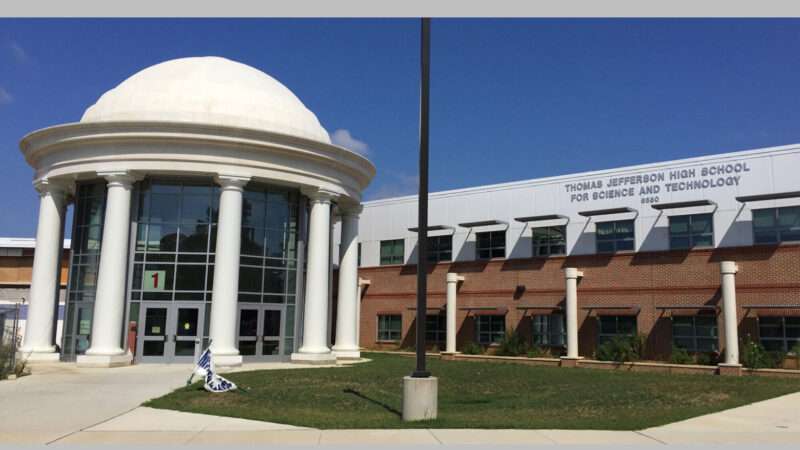

Today the Supreme Court refused to review Coalition for TJ v. Fairfax County School Board, a case in which the Thomas Jefferson High School for Science and Technology ("TJ")—a selective high public school in Fairfax County, Virginia —used facially neutral means to to reduce the percentage of Asian students it admitted. In 2020, TJ adopted a new admissions policy that, while neutral on its face, was actually intended to reduce the percentage of Asian-American applicants accepted at the school, in order to increase the percentage of other groups, and get a student body closer to the population demographics of Fairfax County (which is about 19% Asian).
I criticized the Fourth Circuit appellate court opinion in this case here, analyzed the district ruling in favor of the plaintiffs here.
Before proceeding, I should note that my wife, Alison Somin, is one of the Pacific Legal Foundation attorneys representing the plaintiffs in this case (a group of parents of Asian-American applicants to TJ), on a pro bono basis. If you want to discount what I say because of this connection, you are free to do so. But my interest in both anti-Asian discrimination in education and the more general issue of the use of "facially neutral" policies for discriminatory purposes long predates Alison's work on the TJ case. Anyone who cares to check will, I think, find that my take on the case is completely consistent with my previously expressed views on these two interconnected topics.
Justice Samuel Alito (joined by Justice Thomas) wrote a forceful dissent to denial of certiorari, warning that the lower court ruling sets a dangerous precedent (I raised similar concerns myself, as did Judge Allison Jones Rushing in her dissent to the Fourth Circuit ruling):
A group representing applicants for admission to a highly competitive public magnet school brought suit, claiming that changes in the school's admissions requirements violated the Equal Protection Clause. They alleged that the changes were made for the purpose of discriminating on the basis of race, to the detriment of Asian-American applicants. The District Court found that direct and circumstantial evidence supported that claim and issued aninjunction against implementation of the changes. On appeal, however, a divided Fourth Circuit panel reversed and held that the plaintiff 's claim failed simply because the challenged changes did not reduce the percentage of Asian-American admittees below the percentage of Asian-American students in the schools in the jurisdictions served by the magnet school. What the Fourth Circuit majority held, in essence, is that intentional racial discrimination is constitutional so long as it is not too severe. This reasoning is indefensible, and it cries out for correction….
The panel majority held that the Coalition could not prevail because, as the majority saw things, the new policy "visit[ed] no racially disparate impact on Asian American students" since, even after use of the new policy began, Asian Americans still received 54.36 percent of the admissions offers [compared to the previous 73%]….This percentage exceeded the percentage of Asian- American students in the applicant pool, and therefore, according to the panel majority's reasoning, Asian-American students had no cause to complain. As the panel majority put it, "an application of elementary arithmetic shows that Asian American students, as a class, experience no material disadvantage under the policy's functioning" and in fact perform "better in securing admission to TJ than students from any other racial or ethnic group…."
As Judge Rushing explained in dissent, under the Fourth Circuit's view, the Constitution permits "facially neutral laws explicitly motivated by racial discrimination, as long as the law's negative effect on the targeted racial group pushes it no lower than other racial groups…." "It would not matter, for example, if a new law cut a racial group's success rate from 90% to 30% and the legislature was open about its discriminatory purpose, as long as no other racial group succeeded at a higher rate…. " This rule defies law and logic.
Consider the following hypothetical case. Suppose that white parents in a school district where 85 percent of the students are white and 15 percent are black complain because 10 of the 12 players (83 percent) on the public high school basketball team are black. Suppose that the principal emails the coach and says: "You have too many black players. You need to replace some of them with white players." And suppose the coach emails back: "Ok. That will hurt the team, but if you insist, I'll do it." The coach then takes five of his black players aside and kicks them off the team for some contrived—but facially neutral—reason. For instance, as cover, he might institute a policy that reserves a set number of spots on the roster for each of the middle schools who feed to the high school. According to the reasoning of the Fourth Circuit majority, this action would not violate equal protection because the percentage of black players left on the team (approximately 42 percent) would exceed the percentage of black students in the school. I cannot imagine this Court's sustaining such discrimination, but in principle there is no difference between that imaginary case and one now before us.
As the district court found, the record in this case is full of statements indicating that race was the primary motivation for for the change in admissions policies, and that the School Board specifically sought to reduce the number of Asian students in order to increase the percentage of blacks and Hispanics, and also to—as the TJ principal put it—ensure the TJ student body better "reflect[s] the racial composition in [the Fairfax County Public Schools].'" Other officials claimed that having too many Asian students was in itself harmful because it would damage TJ's "culture." State legislator Mark Keam fulminated about the "unethical ways" Asian-American parents "push their kids into [TJ]," when those parents are "not even going to stay in America," but instead are "using [TJ] to get into Ivy League schools and then go back to their home country."
The Fourth Circuit could have limited themselves to holding (wrongly, in my view) that the School Board would have adopted the new policy even in spite of illicit racial motivation; this is the relevant legal standard under longstanding Supreme Court precedent. But they went beyon that and made a much worse decision, holding that evidence of racist motivation is simply irrelevant so long as the group discriminated against is still represented at a higher rate than its percentage of the applicant pool. That's a dangerous precedent that can easily be abused in many circumstances, by both right and left-wing policy makers.
As I have previously noted, anti-Asian policies at TJ and many other elite educational institutions are reminiscent of efforts to reduce the number of Jewish students at many elite colleges in the early 20th century. Those policies, too, were often facially neutral, and in many cases the number of Jewish students admitted was still higher than the percentage of Jews in the applicant pool or in the general population. Yet, today, few doubt these policies qualify as anti-Semitic discrimination. The same reasoning should apply to the TJ case and others like it.
While the Court has refused to take the TJ case, the issues it raises are likely to recur. In the wake of the Supreme Court's decision in SFFA v. Harvard severely restricting open use of racial preferences in admissions, many schools are likely to use facially neutral means to achieve the same ends, by deliberately using admissions criteria that correlated with race. The problem of efforts to reduce the number of Asian students at elite institutions is also far from unique to this case. Indeed, it arose in the Harvard case itself.
The Supreme Court can run from these questions. But it can't hide from them for very long. If the justices try to do so, more and more institutions are likely to find "race neutral" ways to circumvent the Court's decision, and to target Asian students.
The post Supreme Court Refuses to Hear Case Involving Use of Race-Neutral Means to Facilitate Anti-Asian Discrimination at Selective Public High School appeared first on Reason.com.







